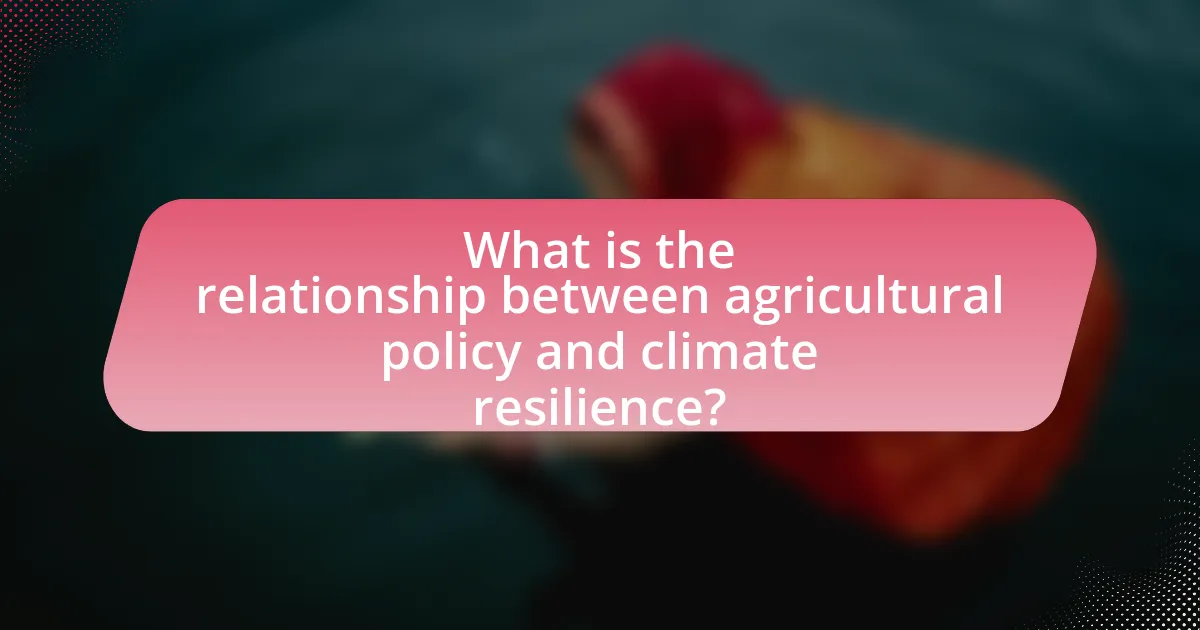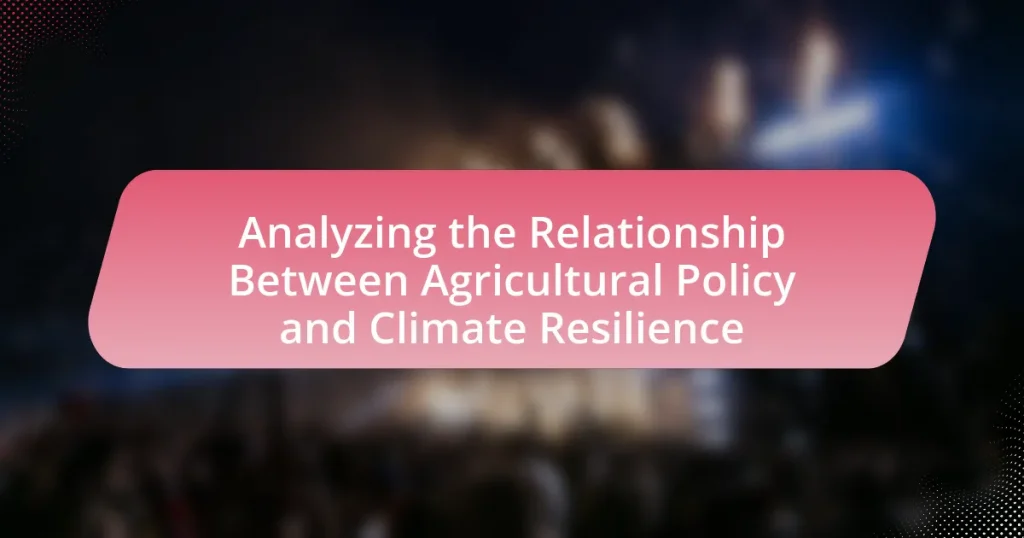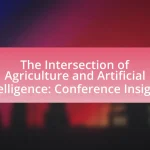The article analyzes the relationship between agricultural policy and climate resilience, highlighting how effective policies can enhance farming systems’ ability to withstand climate-related shocks. It discusses key components of agricultural policies, such as sustainable land management, crop diversification, and investment in climate-smart agriculture, which collectively contribute to resilience against climate change impacts. The article also examines the role of stakeholders in shaping these policies, the challenges faced in aligning agricultural practices with climate resilience goals, and emerging trends that prioritize sustainability and adaptation in agriculture.

What is the relationship between agricultural policy and climate resilience?
Agricultural policy directly influences climate resilience by shaping practices that enhance the ability of farming systems to withstand climate-related shocks. Effective agricultural policies promote sustainable land use, support crop diversification, and encourage the adoption of climate-smart agricultural techniques. For instance, policies that incentivize the use of drought-resistant crop varieties can significantly reduce vulnerability to climate extremes, as evidenced by studies showing that regions implementing such policies experience lower crop failure rates during droughts. Additionally, agricultural policies that integrate climate risk assessments into planning processes help farmers adapt to changing climatic conditions, thereby strengthening overall resilience in the agricultural sector.
How do agricultural policies influence climate resilience?
Agricultural policies significantly influence climate resilience by shaping farming practices, resource allocation, and adaptation strategies. These policies can promote sustainable agricultural methods, such as crop diversification and conservation tillage, which enhance soil health and reduce vulnerability to climate impacts. For instance, the implementation of the European Union’s Common Agricultural Policy has incentivized farmers to adopt environmentally friendly practices, leading to improved resilience against extreme weather events. Additionally, policies that support research and development in climate-smart agriculture provide farmers with the tools and knowledge necessary to adapt to changing climatic conditions, thereby strengthening overall agricultural resilience.
What are the key components of agricultural policies that affect climate resilience?
Key components of agricultural policies that affect climate resilience include sustainable land management practices, investment in research and development for climate-smart agriculture, and the promotion of crop diversification. Sustainable land management practices, such as agroecology and conservation tillage, enhance soil health and reduce erosion, which are critical for maintaining productivity under changing climate conditions. Investment in research and development fosters innovation in crop varieties that are more resilient to climate stressors, such as drought and pests. Additionally, promoting crop diversification helps farmers mitigate risks associated with climate variability by spreading production across different species, thereby enhancing food security and economic stability. These components collectively contribute to building resilience in agricultural systems against climate change impacts.
How do these components interact with climate change impacts?
Agricultural policies and climate resilience components interact by shaping how farming practices adapt to climate change impacts. Effective agricultural policies can promote sustainable practices, such as crop diversification and soil conservation, which enhance resilience against climate-related stresses like droughts and floods. For instance, the adoption of climate-smart agriculture, supported by policies, can lead to improved yields and reduced greenhouse gas emissions, thereby mitigating climate change effects. Research indicates that countries implementing adaptive agricultural policies experience better food security and economic stability in the face of climate variability, demonstrating the critical link between policy frameworks and climate resilience in agriculture.
Why is climate resilience important for agriculture?
Climate resilience is crucial for agriculture because it enables farming systems to withstand and adapt to climate-related shocks, ensuring food security and economic stability. Agriculture is highly vulnerable to climate change impacts, such as extreme weather events, droughts, and shifting growing seasons, which can lead to reduced crop yields and increased production costs. For instance, the Intergovernmental Panel on Climate Change (IPCC) reports that climate change could reduce global agricultural productivity by up to 30% by 2050 if no adaptive measures are taken. Therefore, enhancing climate resilience through sustainable practices, such as crop diversification and improved water management, is essential for maintaining agricultural productivity and supporting rural livelihoods in the face of climate variability.
What are the potential risks of climate change to agricultural systems?
Climate change poses significant risks to agricultural systems, including altered precipitation patterns, increased temperatures, and the prevalence of pests and diseases. These changes can lead to reduced crop yields, affecting food security and farmer livelihoods. For instance, a study by the Intergovernmental Panel on Climate Change (IPCC) indicates that global crop yields could decline by up to 25% by 2050 due to climate-related factors. Additionally, extreme weather events, such as droughts and floods, can disrupt planting and harvesting schedules, further jeopardizing agricultural productivity.
How can climate resilience enhance food security?
Climate resilience enhances food security by enabling agricultural systems to withstand and adapt to climate-related shocks, thereby ensuring consistent food production. Resilient agricultural practices, such as crop diversification and improved water management, reduce vulnerability to extreme weather events, which can disrupt food supply chains. For instance, a study by the Food and Agriculture Organization (FAO) indicates that implementing climate-smart agriculture can increase yields by up to 30% in regions prone to climate variability. This adaptation not only stabilizes food availability but also supports livelihoods, contributing to overall food security.
What role do stakeholders play in shaping agricultural policy for climate resilience?
Stakeholders play a crucial role in shaping agricultural policy for climate resilience by influencing decision-making processes and ensuring that diverse perspectives are considered. These stakeholders include farmers, agricultural organizations, government agencies, NGOs, and researchers, each contributing unique insights and expertise. For instance, farmers provide firsthand knowledge of climate impacts on their practices, while NGOs advocate for sustainable practices and policies that prioritize environmental health. Research shows that inclusive stakeholder engagement leads to more effective policies; a study by the Food and Agriculture Organization highlights that participatory approaches enhance policy relevance and effectiveness in addressing climate challenges. Thus, the active involvement of stakeholders is essential for developing agricultural policies that are resilient to climate change.
Who are the key stakeholders involved in agricultural policy-making?
The key stakeholders involved in agricultural policy-making include government agencies, farmers, agricultural organizations, non-governmental organizations (NGOs), and the private sector. Government agencies, such as the Department of Agriculture, formulate and implement policies that affect agricultural practices and sustainability. Farmers represent the primary producers whose interests and needs are central to policy decisions. Agricultural organizations, including cooperatives and trade associations, advocate for the interests of their members and provide expertise. NGOs contribute by addressing social and environmental issues related to agriculture, often influencing policy through research and advocacy. The private sector, including agribusinesses and food companies, plays a significant role in shaping policies through investment and innovation. These stakeholders collectively influence agricultural policy, impacting climate resilience and sustainability efforts.
How do stakeholder interests align or conflict regarding climate resilience?
Stakeholder interests regarding climate resilience often align in their shared goal of sustainable development but can conflict due to differing priorities and resource allocations. For instance, farmers may prioritize immediate economic gains from agricultural practices, while environmental groups advocate for long-term ecological health, leading to tensions over land use and resource management. Additionally, government policies may favor industrial agriculture, which can undermine local resilience efforts, creating a conflict between large-scale agricultural stakeholders and community-based initiatives aimed at enhancing climate adaptation. This dynamic illustrates the complexity of stakeholder interactions, where alignment on overarching goals can be disrupted by specific interests and competing agendas.
How can agricultural policies be designed to improve climate resilience?
Agricultural policies can be designed to improve climate resilience by promoting sustainable practices, enhancing resource management, and supporting research and innovation. Implementing policies that incentivize crop diversification, soil health improvement, and water conservation can help farmers adapt to changing climate conditions. For instance, the Food and Agriculture Organization (FAO) emphasizes that integrating climate-smart agriculture practices can increase productivity while reducing greenhouse gas emissions. Additionally, providing financial support and technical assistance for farmers to adopt resilient technologies, such as drought-resistant crops, can further enhance their ability to withstand climate impacts. Evidence from various studies indicates that countries implementing such policies have seen improved agricultural yields and reduced vulnerability to climate-related shocks.
What best practices can be implemented in agricultural policy for climate adaptation?
Best practices for agricultural policy aimed at climate adaptation include promoting sustainable farming techniques, enhancing water management systems, and supporting research and development for climate-resilient crops. Sustainable farming techniques, such as crop rotation and agroforestry, improve soil health and biodiversity, which are essential for resilience against climate impacts. Enhanced water management systems, including rainwater harvesting and efficient irrigation practices, help mitigate water scarcity, a significant concern in changing climates. Furthermore, investing in research and development for climate-resilient crops can lead to varieties that withstand extreme weather conditions, thereby securing food production. These practices are supported by evidence from various studies, such as the Food and Agriculture Organization’s reports on sustainable agriculture, which highlight the effectiveness of these strategies in improving resilience to climate change.
How can technology and innovation support climate-resilient agricultural policies?
Technology and innovation can support climate-resilient agricultural policies by providing advanced tools and practices that enhance productivity while minimizing environmental impact. For instance, precision agriculture utilizes data analytics and IoT devices to optimize resource use, reducing water and fertilizer consumption by up to 30%, as reported by the Food and Agriculture Organization. Additionally, innovations such as drought-resistant crop varieties and climate-smart farming techniques enable farmers to adapt to changing weather patterns, thereby increasing resilience against climate-related shocks. These technological advancements not only improve food security but also align agricultural practices with sustainability goals, demonstrating their critical role in shaping effective climate-resilient policies.
What are the challenges in aligning agricultural policy with climate resilience goals?
Aligning agricultural policy with climate resilience goals faces several challenges, primarily due to conflicting priorities and limited resources. Policymakers often prioritize short-term economic gains over long-term sustainability, leading to practices that may undermine climate resilience. For instance, the reliance on monoculture farming can increase vulnerability to climate impacts, as diverse ecosystems are more resilient. Additionally, insufficient funding for research and development in sustainable agricultural practices hampers innovation. According to the Food and Agriculture Organization, only 3% of global climate finance is directed towards agriculture, highlighting the disparity in resource allocation. Furthermore, the lack of collaboration among stakeholders, including farmers, governments, and NGOs, complicates the implementation of integrated policies that address both agricultural productivity and climate adaptation.
What barriers exist in the implementation of climate-resilient agricultural policies?
Barriers in the implementation of climate-resilient agricultural policies include insufficient funding, lack of technical knowledge, and inadequate infrastructure. Insufficient funding limits the ability to invest in necessary technologies and practices that enhance resilience. A lack of technical knowledge among farmers and policymakers hinders the adoption of innovative practices that could mitigate climate impacts. Additionally, inadequate infrastructure, such as poor irrigation systems and transportation networks, restricts access to markets and resources essential for implementing these policies effectively. These barriers collectively impede the progress toward sustainable agricultural practices that can withstand climate change.
How can these challenges be overcome?
To overcome challenges in the relationship between agricultural policy and climate resilience, policymakers must integrate adaptive strategies that enhance sustainability and resource management. Implementing practices such as crop diversification, soil health improvement, and water conservation techniques can significantly increase resilience to climate impacts. For instance, research by the Food and Agriculture Organization indicates that adopting agroecological practices can lead to a 20-30% increase in crop yields under climate stress conditions. Additionally, establishing financial support mechanisms for farmers to adopt these practices can mitigate risks associated with climate variability.
What are the future trends in agricultural policy and climate resilience?
Future trends in agricultural policy and climate resilience include a shift towards sustainable practices, increased investment in technology, and enhanced collaboration between stakeholders. Policymakers are prioritizing climate-smart agriculture, which integrates practices that improve productivity while reducing greenhouse gas emissions. For instance, the adoption of precision agriculture technologies is expected to rise, allowing farmers to optimize resource use and minimize environmental impact. Additionally, there is a growing emphasis on agroecological approaches that promote biodiversity and soil health, as evidenced by initiatives like the European Union’s Farm to Fork Strategy, which aims to make food systems fair, healthy, and environmentally-friendly. These trends reflect a recognition of the need for adaptive strategies that can withstand climate variability and ensure food security in the face of climate change.
How is climate change expected to shape future agricultural policies?
Climate change is expected to significantly influence future agricultural policies by necessitating adaptations that enhance resilience and sustainability. As climate patterns shift, policies will likely focus on promoting practices that mitigate greenhouse gas emissions, such as adopting conservation tillage and improving crop rotation. Additionally, the increasing frequency of extreme weather events will drive the implementation of risk management strategies, including crop insurance and disaster relief programs, to support farmers facing climate-related challenges. Evidence from the Intergovernmental Panel on Climate Change indicates that without proactive policy changes, global food security could be jeopardized, underscoring the urgent need for agricultural policies that prioritize climate adaptation and resilience.
What emerging practices are being adopted for enhanced climate resilience?
Emerging practices being adopted for enhanced climate resilience include agroecological farming, which integrates ecological principles into agricultural practices to improve soil health and biodiversity. This approach has been shown to increase crop yields by 20-50% while reducing reliance on chemical inputs, as evidenced by research from the Food and Agriculture Organization. Additionally, the implementation of climate-smart agriculture techniques, such as crop rotation and intercropping, helps farmers adapt to changing climate conditions and mitigate greenhouse gas emissions. These practices are increasingly supported by agricultural policies aimed at promoting sustainability and resilience in farming systems.
What practical steps can policymakers take to enhance agricultural resilience to climate change?
Policymakers can enhance agricultural resilience to climate change by implementing adaptive management practices, promoting sustainable agricultural techniques, and investing in research and development. Adaptive management practices, such as crop rotation and diversification, help farmers adjust to changing climate conditions, thereby reducing vulnerability. Sustainable agricultural techniques, including conservation tillage and integrated pest management, improve soil health and water efficiency, which are crucial under climate stress. Additionally, investing in research and development fosters innovation in climate-resilient crop varieties and farming technologies, as evidenced by the success of drought-resistant crops developed through public-private partnerships, which have shown yield improvements of up to 30% in arid regions.















